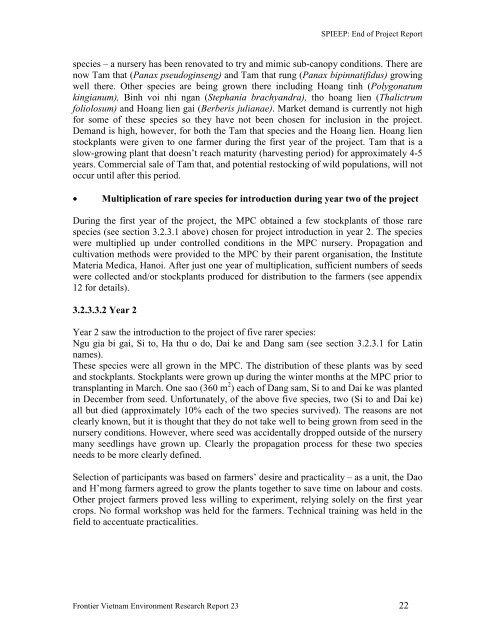Frontier Tanzania Environmental Research - Frontier-publications ...
Frontier Tanzania Environmental Research - Frontier-publications ...
Frontier Tanzania Environmental Research - Frontier-publications ...
Create successful ePaper yourself
Turn your PDF publications into a flip-book with our unique Google optimized e-Paper software.
SPIEEP: End of Project Reportspecies – a nursery has been renovated to try and mimic sub-canopy conditions. There arenow Tam that (Panax pseudoginseng) and Tam that rung (Panax bipinnatifidus) growingwell there. Other species are being grown there including Hoang tinh (Polygonatumkingianum), Binh voi nhi ngan (Stephania brachyandra), tho hoang lien (Thalictrumfoliolosum) and Hoang lien gai (Berberis julianae). Market demand is currently not highfor some of these species so they have not been chosen for inclusion in the project.Demand is high, however, for both the Tam that species and the Hoang lien. Hoang lienstockplants were given to one farmer during the first year of the project. Tam that is aslow-growing plant that doesn’t reach maturity (harvesting period) for approximately 4-5years. Commercial sale of Tam that, and potential restocking of wild populations, will notoccur until after this period.• Multiplication of rare species for introduction during year two of the projectDuring the first year of the project, the MPC obtained a few stockplants of those rarespecies (see section 3.2.3.1 above) chosen for project introduction in year 2. The specieswere multiplied up under controlled conditions in the MPC nursery. Propagation andcultivation methods were provided to the MPC by their parent organisation, the InstituteMateria Medica, Hanoi. After just one year of multiplication, sufficient numbers of seedswere collected and/or stockplants produced for distribution to the farmers (see appendix12 for details).3.2.3.3.2 Year 2Year 2 saw the introduction to the project of five rarer species:Ngu gia bi gai, Si to, Ha thu o do, Dai ke and Dang sam (see section 3.2.3.1 for Latinnames).These species were all grown in the MPC. The distribution of these plants was by seedand stockplants. Stockplants were grown up during the winter months at the MPC prior totransplanting in March. One sao (360 m 2 ) each of Dang sam, Si to and Dai ke was plantedin December from seed. Unfortunately, of the above five species, two (Si to and Dai ke)all but died (approximately 10% each of the two species survived). The reasons are notclearly known, but it is thought that they do not take well to being grown from seed in thenursery conditions. However, where seed was accidentally dropped outside of the nurserymany seedlings have grown up. Clearly the propagation process for these two speciesneeds to be more clearly defined.Selection of participants was based on farmers’ desire and practicality – as a unit, the Daoand H’mong farmers agreed to grow the plants together to save time on labour and costs.Other project farmers proved less willing to experiment, relying solely on the first yearcrops. No formal workshop was held for the farmers. Technical training was held in thefield to accentuate practicalities.<strong>Frontier</strong> Vietnam Environment <strong>Research</strong> Report 23 22
















